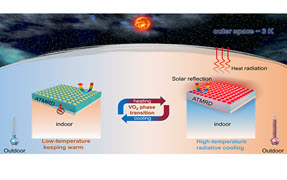Listening to terahertz electromagnetic waves
Terahertz (THz) electromagnetic waves have remarkable and unique abilities for imaging, chemical identification, and penetration of many optically opaque barriers. Photon energies at these frequencies are relatively small (meV), which means the radiation is non-ionizing and therefore considered biologically innocuous. With the growing list of applications and demand for THz technology, THz sources and detectors have improved significantly, creating opportunities for realizable commercial and national defense related devices.

Despite its advantages, THz radiation also presents several challenges. First, absorption of THz waves in the atmosphere at habitable altitudes can be greater than 100dB/km due to fundamental vibrational and rotational resonant modes of water molecules that absorb the waves' energy. In comparison, visible light is attenuated about 0.02dB/km. For this reason, THz radiation is only operated at either extremely short distances (several centimeters), or under dry nitrogen-purged laboratory environments. Second, with traditional measurement techniques, it is only possible to obtain THz wave information in the forward propagating direction, which is impractical for remote applications. Third, existing detection methods require either electro-optic crystals or electrodes at the point of detection, meaning they must be performed on a very local scale. Therefore, there is a need to use the powerful yet non-invasive material and vapor identification abilities of THz waves while extending the effective distances over which the technology can be used.

Recently, we demonstrated that two intense optical beams focused into the air can generate intense broadband THz radiation at distances up to 30m and with pulse energies up to 250nJ through the photoionization process.1, 2 While this is a step towards realizing remote THz sensing, obtaining information on the wave from these distances is still a problem. It is well known that when a laser plasma is formed through photoionization, it releases energy in the form of acoustic waves. After photoionization, the remaining portion of the laser pulse accelerates freed electrons inside the plasma. Collisions between hot electrons and their surrounding air molecules produce an increase in localized gas temperature that results in the release of a shock wave that quickly relaxes into a broadband acoustic pulse. What is less known is that THz wave information, on the picosecond time scale, can be encoded into these acoustic waves, making it possible to retrieve this information from any direction without electro-optic crystals, electrodes, or the penalty of high water vapor attenuation of the encoded signal.3
To encode THz information into acoustic waves, it is first necessary to create asymmetric electron motion inside the plasma by introducing a second optical field at twice the frequency. By carefully selecting the phase between these two optical pulses, a dominant electron motion parallel or antiparallel to the laser pulse polarization can make the electron drift velocity asymmetric.4, 5 Figure 1 shows the acoustic amplitude of the plasma as the THz pulse is scanned in time relative to the plasma formation for the three aforementioned scenarios of electron motion relative to the THz electric field.
When a pulse is introduced into each respective scenario for which the freed electrons have acquired antiparallel, symmetric, or parallel drift in relation to the THz field before the first collision event, electrons are either slightly accelerated, unaltered, or decelerated by the field, respectively. Taking the difference in acoustic emission for parallel and antiparallel scenarios eliminates acoustic enhancement contributed by electron kinetic energy transfer after the first collision event (for which electron trajectory is randomized and no longer coherent). The resulting information reveals this energy transfer, which is directly proportional to the field.6 Ultimately, this means we can recover a coherent waveform by ‘listening’ to the interaction between THz waves and an asymmetric laser-induced plasma. Figure 2 shows the pulse retrieved through acoustics and through traditional methods for comparison.
In conclusion, our acoustic technique uses the powerful capabilities of THz radiation for non-invasive imaging and chemical identification, and it uncovers new opportunities for overcoming some of the greatest limitations of THz wave technology. In the future, we hope to gain a deeper understanding of the collisional energy transfer process by imaging the photoacoustic shock wave using a gated, intensified, charge-coupled device that will allow us to visualize the evolution of the pressure waves under the influence of high-field THz radiation.
Benjamin Clough is an Integrative Graduate Education and Research Traineeship (IGERT) fellow pursuing his PhD in electrical engineering under Professor Xi-Cheng Zhang. He is the recipient of numerous awards including the 2009 RPI Founders Award of Excellence, the 2010 IGERT Best Presenter Award, and the 2011 Lemelson-MIT Student Prize.
Jingle Liu received his PhD in physics in 2010. He has received numerous awards including the 2009 RPI Founders Award of Excellence, the 2010 Huntington Award for Outstanding Achievement, and the 2011 Northeastern Association Graduate School Best PhD Thesis Award. He is currently working at Bloomberg L.P.
Xi-Cheng Zhang joined Rensselaer in 1992. He is currently the acting head at the Department of Physics, Applied Physics and Astronomy and professor of the Department of Electrical, Computer and Systems Engineering, and the founding director of the Center for THz Research. Zhang has authored and coauthored numerous books, scientific papers, and has delivered hundreds of invited presentations internationally.



